ARCHITECTURAL PROJECTS
RESIDENTIAL
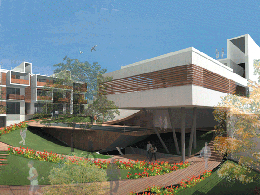
08 December, 2010
Metaxekisis : Re-Thinking the Athenian Court
Metaxourgeion Multi-Programmatic archetypes open architectural competition entry, Spring 2006
Architectural Design: Aristotelis Dimitrakopoulos,Themistoklis Charalambides.
Collaborators: Eugene Oh, Nikos Baramboutis, J.E. Gonzalez.
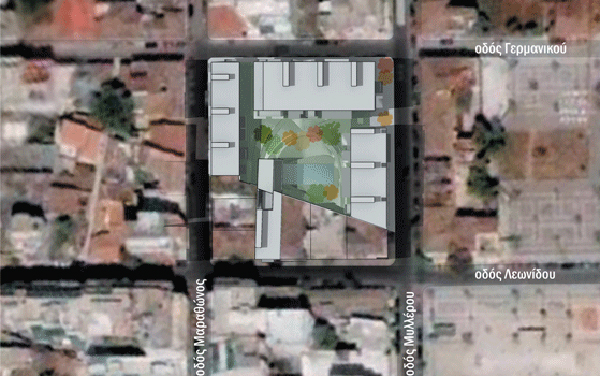
Project Data: This international competition was entered in collaboration with Themistoklis Charalambides. Eugene Oh of New York had primary responsibility of the physical model and J.E. Gonzalez of San Francisco contributed during the final editing stages of the computer generated renderings. Nikos Baramboutis from Athens was the collaborating structural engineer. Themistoklis worked at the time for SOM NYC in Wall Street and Aristotelis was teaching full-time graduate level in Savannah. With the exception of Themis and Eugene, none of the other team members met in person for this project. All communication, document and design discussion happened online, through ftp sites and teleconferencing frequently assisted by cameras during design sessions. Aristotelis never met in person with Nikos until a month after the entry submission, and up to date has never met the other U.S. collaborators. Teamleaders and producers of the work submitted on the four A1 panels were Aristotelis Dimitrakopoulos [Dipl. Eng NTUA, M.Arch. Yale] and Themistoklis Charalambides [Dipl. Eng NTUA, M.Arch. UCLA].
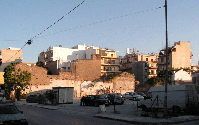
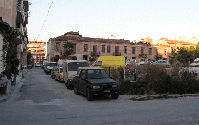
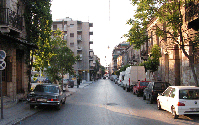
Design Premise: The competition appeared exciting primarily because of the project location and the programmatic outset. Metaxourgeion is a neglected and underdeveloped central district, and this project is the first step towards a process of rethinking the area. The potential of recovering and re-densifying the originally residential district - later turned into a deteriorated semi-industrial slam with all the subsequent problematic of a neglected city sector - addressed the issue of new housing development in tight urban sectors, a potent terrain for experimentation on alternatives to the growth observed in the periphery. The desire for privacy, which drives most people towards a single-family home at great personal cost and tremendous public expense, is questionable, both economically and ecologically. Instead of tolerating suburban life and sacrificing the establsihed cultural and social idioms, the project offers the potential for occupants to define individually the housing parti that meets personal needs, also enabling the possibility of future growth/re-design for each unit; qualities that differentiate the life politics in high-density housing in the city from the supposedly countrified lifestyle in the periphery.
Athenian Problematic: The project showcases the difficulties of designing in central Athens. Here, architects are confronted with a rough locale. Aesthetically uncontrolled development has produced an anarchic visual chaos. The process of urban deterioration has accelerated due to the total absence of planning strategies. The site is tight with an overwhelming [quantitatively] program both in terms of surface and volume; harsh adjacencies, a widely varied contextual fabric of poor speculative character, urban spaces of indeterminate character, underutilized and poorly designed, and extreme building code regulations.
Aoristically Immune: The traffic-network consists mainly of narrow streets, 8-11m wide [sidewalks included] accommodating mostly local traffic. An exception is the 9m wide two-lane one-way street that fronts the north of the block, a busy traffic connector between the city center to the motorway. Smog is an everyday condition in downtown Athens mainly because of poor public transportation networks constant traffic in the downtown area. The heavily polluted air is only one of many environmental consequences.
Building Context: The overbuilt urban fabric is structured of low-cost [on average] 5-story residential slabs called poly-katoikia [derives from poly-kat-ecos, meaning multi-residence]. Currently, the housing units in many cases accommodate private offices (or shops on ground levels), as the quality of the environment has made the territory inappropriate for permanent habitation. Many of these monolithic buildings were constructed cheaply, demolishing noble neoclassic residences. Almost identical indifferent slabs stand autistically aloof within the city generating these monotonous daunting stretches of streetscape. Public and green spaces are suppressed to a minimum in the locality. Most free spaces are either turned into parking lots or have evolved into neglected junkyards.
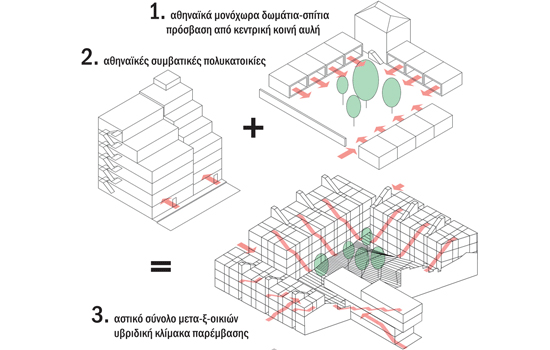
Legal Restrictions: The straightforward request to maximally enlarge the habitable surfaces is in total contrast to the numerous and heavy constraints: height limits, alignments, legally permitted distances. The overall building shapes were determined with an innovative interpretation of restrictions imposed through building code. Every inch of space gained through the manipulation of planning controls is typically valued as a precious commodity.
According to code, the maximum permitted building height at any point is 1½ of the distance of this point to the opposite neighboring building. This explains the recess of the upper levels in section -typical characteristic of existing building structures locally. The new building had to descend towards the lower street corner, conforming to planning control restrictions. Anti-seismic structural design regulations impose additional extraordinary restrictions.
Urban Oasis: The architectural proposal endeavors to revamp the uninspired domestic locale by utilizing elements from the city context. The overall architectural approach creates synergy with existing conditions and fabrics by investigating the immediate urban conditions and the morphology of precedents: the surrounding polykatoikias and the inscribed habitation norms. As an answer, a microcosm is generated, an independent private enclave, sealing off traffic noise, offering privacy undisturbed by the din and the distractions of this downtown quarter and revitalizing the decaying urban area and compensating for existing discontinuities.
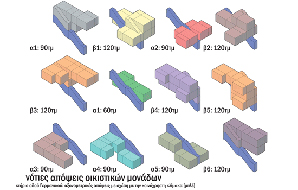
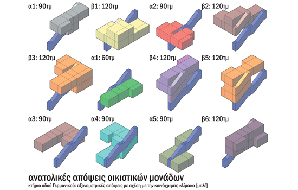
Experimental Initiatives: Multiple site planning concepts were tested, most involving elongated linear volumes that open up towards court space that meets the surrounding streets. This direction entailed the danger of degrading these open spaces and progressively losing control over their use. The linearity of the volumes was also questioned as generally reinforcing the institutional character through long corridors and repetitiveness. As a response to these concerns, the primary scheme discussed consisted of 8 towers set partially on a raised podium [one-story] that accommodated the commercial functions [3 towers along Germanikou Street were set apart from the podium allowing a public corridor to develop in parallel to the street]. These towers interconnected on the 4th or 5th floor through linear volumes spanning across. This was a concept allowing for a variety of moods in the open spaces [either on-top of the podium as semi-private communal space, or on-ground for public use combined with the commercial frontage] differentiated through the elevation change.
The wide cross passage between the towers and the podium connecting north-south [parallel to Germanikou Street] served the ground level retail spaces absorbing the suppressed urban dynamics of the deprived Germanikou Street. This was a high-density urban scheme that defied any notion of introversion allowing the urban condition to infiltrate into the block, in contrast to the final competition scheme that prioritizes the creation of an almost defensive urban haven in the block center.
The evolution of the serial typology of the final "metaxekisis" scheme [etymology follows] released the potential of linear volumes for the synthesis and led to the abandonment of the tower [point-density] scheme. The final organizational scheme for the building services allowed the linear volumes to gain access by way of a series of staircases set at increments on the long sides of the building slabs, as a new type of semi-independent rowhouse system. This caused a major shift in the thinking process and brought back the option of the "segmented donut" concept with the central court, avoiding the institutionalized character.
Metaxekisis: The name of the district is Metaxourgeion [Μεταξουργείο] from Metaxi [silk, or Μετάξι] and Ergo [work, or έργο]. Metaxekisis is a constructed word introduced as project title, from Metaxy [in-between, or μεταξύ] and Ekisis [habitation, or οίκησις]. The rubric describes the experiential condition generated by the developed typology both in plan and in section.
Mutation: The competition brief prioritized flexibility as a central priority for the residential models generated. The project undertook this objective to its extreme. The clarity of the floor plans conveys the potential of the proposed typology. Two modules are generated and alternate, placed across the plan view of each volume. The stair module offers linear flights of stairs for either two or one storey. The flights that connect to the courtyard become the public trajectory. All other flights of stairs connect the various levels as interior private or communal circulation options.
Variation: The multi-functional tectonic system enables increased flexibility, establishing simultaneously sharp and clear spatial conditions - the systems of vertical movement and the services network developing perpendigularly to the longer dimensions of the building volumes. The promise of the system lies on the multiplicity of possible subdivisions, and on the vertical continuity of permanent services that intentionally occupy the deepest zones of the plan, releasing the perimeter. The repetitiveness and regularity, the equilateral views, the repetitive and canonical [permanent] elements [structure, services and enclosure] and the clear visual identity combine with the low construction cost, without compromising the potential for continuous future re-distribution of uses and the re-configuration of the spatial entities.
The interior configuration options range from a single space per level [accross the whole volume] to a very intricate system of multi-level units combining workspace and living. The units can grow vertically and horizontally, interlocking like a habitable tetris game. The interior spaces can be highly customized through countless variations starting from the basic module.
Nouveau Typology: The primary design act can be describes as a rhythmical alternation of two types: an entity accommodating the hygiene spaces, the food preparation and storage along with the elevator shafts; and another entity serving the vertical [and the horizontal movement at once] through the linear staircases. Endless options of physical and programmatic subdivision are possible in response to occupant demographics and to usage mutability. Each building volume may perform as a singular functional entity operating under a single address, or can be divided into units differentiated in form, size and function, offering the possibility for a total subdivision into individual studio units, single-space modules separated by the linear service entities [stairs and lifts/hygiene spaces alternating]. The homogenous and uniform volumetry and the neutrality of the overall scale oppose the holistic potential for a total status of absolute programmatic and organizational micro-fragmentation.
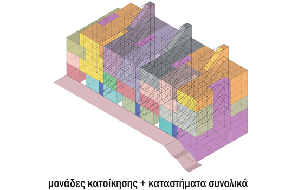
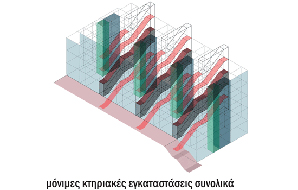
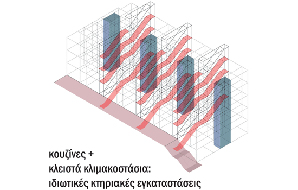
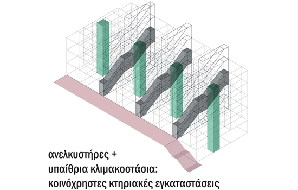
Conceptual Descent: This is a hybrid emerging from the Athenian single-story residential typology [or multi-story, accessible through a central court] and the conventional speculative polykatoikia. It is also a programmatic hybrid, fit for professional or residential use. Coventional polykatoikias are frequently retrofitted as offices, often with poor services and many compromises in terms of image and functionality. Here, conversion and expansion become integral characteristics of the proposed building typology. Selected elements of these anonymously established typologies are introduced, generating a construction prototype that permits the vertical and horizontal expansion of the historic single-space dwelling archetype, with minimized - and perceptually eliminated - repetitiveness of the communal circulation spaces. All multi-level, multi-lateral reconfigurations offer intricate spaces of uniform and controlled quality, allowing the sectional parti to receive primary role in the design process, eventually provoking a sense of sectional domesticity.
Mystical paths: The primary access and circulation principles relate to the historic residential complexes of the city of Athens, establishing the central court as a focal node of everyday domestic life. The system of staircases branching outwards from the main court establishes a potential for constantly changing patterns of connectivity and movement between units and spatial pods generating the dynamics for an intricate interactivity; multiplicities of experiential and programmatic plots within semi-private domains. The stacks of private-use unassigned stairs [above and below the main outdoor access stairways that branch out from the atrium] offer numerous options for the creation of an integral quasi-private system of circulation between units, which can be fully separated from the obvious public circulation network. This provoking potential of a secluded social and communicational status, an idiosyncratic secretive network of interactivity, expresses the promise for an essentially communal living idiom in constant shift.
Programmatic Hybridities: The repetitive system of privatized interior circulation among the various levels serves optimally the combination of programmatic directives such as housing and workplace. The linear repetition of the building unit offers the possibility for horizontal and vertical extension of any programmatic unit with an ultimate effect, the operation of any single building volume as a singular entity, as a single institution. The multi-story private communication through elevators and stairs introduces the unforeseen possibility for multi-spatial poly-programmatic entities combining commercial space with galleries or exhibitions [an art cafι for instance] with workspace and living quarters upwards. The building slab on Germanikou Street is divided in preliminary units of 120m2 [the space between two stairways], the volume on Marathonos Street features modules of 70m2 while the mass on Myllerou Street is divided in increments of 90m2. All these units can be reworked into multiplicities.
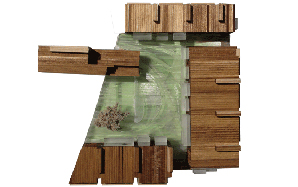
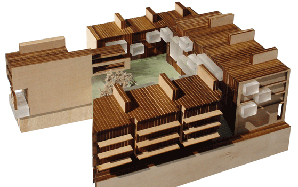
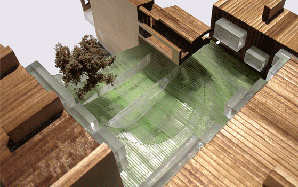
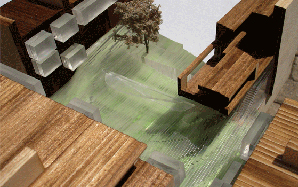
Stairway Distribution: The subdivision options are multiplied if the private stairs receive semi-communal character, shared between the adjoining units-flats. The configuration presented in the drawings displays a scheme with each of the dwelling units making exclusive use of the staircases connecting multiple levels.
Split-Level: The stairways on the building volume facing Myllerou Street were also studied as a split-level system through the half-story shift of each consecutive stair, shifting the landings. This experiment created a more irregular and highly differentiated pattern and allowed for shorter links between adjoining levels. The split-level parti was rejected due to the overwhelming complication of the organizational scheme.
Communality: The highly institutional character of large residential projects is here avoided by minimizing the logistics of circulation - spaces of often poor experiential quality. As in a loft-like scheme, lifts open straight in the apartments [only the entry level offers a small "lobby" for public access]. The communal stairs are visually perceptible from the court, shooting straight towards the street-fronts, not "turning corners". All stairs stacked above/below are private, becoming the enabling component of the multi-level units. This stairway scheme, as a system of elongated, stretched stoops, as discussed previously, relates to the athenian courtyard life and housing typologies, extending on parallel vectors the public space of the court and injecting it into the building.
In-between the housing units there are solely semi-outdoor linkages in a linear manner, in a continuous axis. The ethics of institutionalization evident in the average speculative polykatoikia are precluded: the norm of mediocre circulation and corridor [ironically called "communal"] space per floor eating up prime space cancelling all possibility for programmatic diversity and connectivity both in section and plan, is here avoided.
Add-on Entities: As a proposal for a real project, the building code [of extremely tight regulations and restrictions] is here followed strictly. Major component of the code is the definition of semi-outdoor spaces [recesses and inward-cuts of the volume for outdoor spaces that typically feature a ceiling and side walls] and verandas. Here the "hemiypaithrioi" or semi-outdoor spaces [and all balconies] are cantilevered, simplifying the main body of each building slab, and still offering the advantageous extra square-footage permitted by code. Semi-outdoor spaces project as full boxes missing the outermost side only, while the balconies feature no roof or side walls, thus randomizing the facade of the building.
Atrium Scheme: The conceptual diagrams [see presentation] depict optimally the programming role of the inner court. The common affordable rental spaces in central Athens were single rooms serially laid in one-story volumes accessed via a central court, the event space of everyday life, further linked to the road through a main gate and separated from public view by tall masonry walls. This catalytic role of the court is an absolute priority of the new proposal. Maintaining this priority, the proposed residential typologies react to the established archetype of the polykatoikia, to contemporary standards in residential design and also to the programmatic expectations set in the project brief. Access to all residential units [lifts or stairs] is enabled through the main court solely. Only the retail spaces offer direct access from the street level. The movement scheme establishes the atrium as the urban frontier and communal forum of the complex, activated constantly. The scheme ensures that the residents' perception does not categorize the atrium as a high-end backyard of poor relevance to their daily living routines. Programmatically, the court acts as a raised datum detached from the disturbances of city life. The perception of the court as a reference zone is encouraged. The introversion and inwardness [self-reference] of the polykatoikia evolves here into an outward-looking typology, reinforcing the significance of the court.
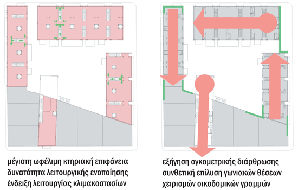
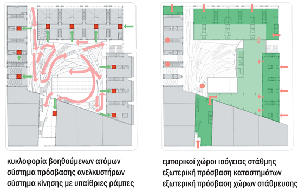
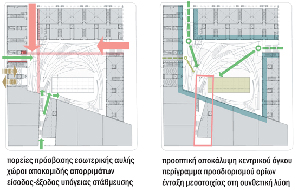
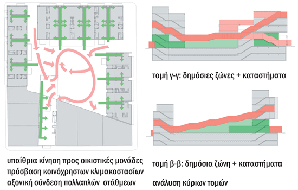
Play=Mound A: The massing of the courtyard space does not compete with the housing volumes [a modernist "slab" base would fall into this trap], but exactly, revisits the concept of the abstract modernist datum [tested initially in the design process] through post-cartesian geometrical notions towards the smooth territory. The concept of the raised datum initiated from the intention to separate between public and intimate zones within the unbuilt portion of the site. Then the confrontation with the precedent typologies of the modernist pseudo-monumental abstract pedestal [common in the arrogant "superior" urban interventions of corporate modernism] was resolved through the adoption of non-eucledian geometrical forms. In short, the concept for the interior courtyard design is the "play:mound" and springs from the natural drop in topography on-site, exaggerated in response to the programmatic parti. Indirectly, this feature reconstitutes the loss of the natural topography in the athenian city that has become a violently flattened-out terrain resisting all topographic deviations. Simultaneously, this formal directive becomes a smart game manipulating building codes and allowing softer transitions responding to the requirements for coverage, maximum footage etc.
Play=Mound B: The private landscape is not internalized but maintains a level of domestic atmosphere allowing for communal activities. The formal entity offers a sense of breadth and unification to the complex through a simple geometrical idea -the mound- geometricized as a new artificial topology. Functionally, the higher portions of the volume contain deep commercial space accessed through Myllerou and Leonidou streets, with discreet skylights allowing sunlight penetration.
The mound reproduces greatly the existing natural contour system [partially offsetting it vertically] and establishes a variable plateau acting as an urban playground avoiding redundant formal or directional definitions and allowing individual interpretations to emerge. The surface manipulation phase started early in the design process ensuring that programmatic activities would be embedded within the formal parti. This intricate internal urbanscape is perceived from all axes, directions and orientations imposing no favoritism and limitations in terms of positioning and accessibility. The rejection of pretentious abstractedness and monumentality -typical of the modernist compositional archetype of a slab [monolith] on a pedestal, is manifested here with a tangible solution prioritizing human comfort and adaptability, daily enjoyment and malleability. This version of a pliable softscape of bendiness and suppleness meets the needs of all age groups regardless of physical ability, avoiding the institutionalized traditions of separation between the movement options for the "able" and the disabled.
Steps and ramps are incorporated into the surface volumetry, with softened edges intertwined into the landscape patches that visually differentiate the uninterrupted continuity of the massing.
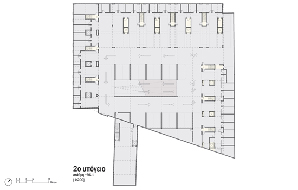
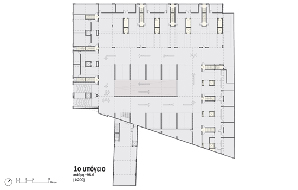
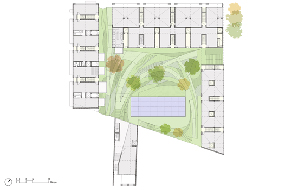
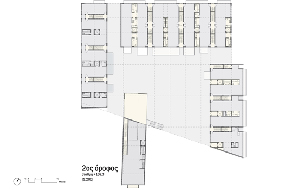
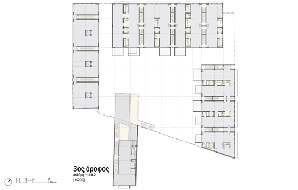
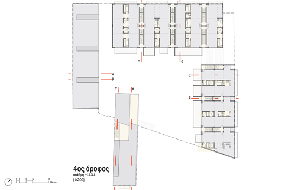
Thru Passages: The interior courtyard is accessed from each street through stoas [Marathonos and Leonidou Streets] or voids [Myllerou, Germanikou]. The decision for the width and the position of the volume disruptions came through a long process of experimentation and discussion. In short, it was desired not to seal the perimeter of the property with continuous building volumes. The definition of the open ends [shorter sides of each volume] of the final proposal is inherently not be an easy design issue, however, the added openness communicates [from the curbside of the public streets] the inner characteristics of the complex through long perspectives, revealing at a great degree the urban role of the atrium. A continuous built volume would make perfect sense as the obvious state of a fully developed urban block, however, here, a continuous scheme would appear [from the street] as a mere scenographic intervention disabling the potential for visual interaction between the inner court space and the streets; a scenario made possible here through the rare opportunity to control three quarters of a total Athenian block.
There are four distinct volumes comprising the total proposal, each responding to its respective street-front. The location of the in-between voids was decided in response to contextual conditions, to existing heights, to changes of pattern or typology. The formal differentiation is strong between the various street-front elevations.
Myllerou Link: The opening on Myllerou Street enables diagonal views from the court area towards the main historic symbol of the district, the Metaxourgeion building that currently hosts cultural events awaiting a full restoration. The building code requirement for a two-story stoa terminates before the street-corner, therefore corresponds to the termination of the Myllerou volume and the passage location. The Germanikou volume hits the corner with Myllerou generating a more upright frontage set-back from the street edge in response to property lines, causing this tall detached surface to act as a static independent spectacle in the very linear streetscape. This vertical tall faηade becomes a visual stasis moment for the driver or the passerby anchoring the sight as an absorbing release point within the restless city. From the street, glimpses of the hovering "folie" volume amidst the courtyard are possible, betraying the joys of the new complex.
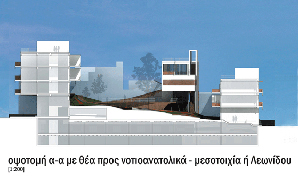
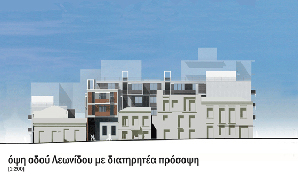
Marathonos Link: Slightly deviating off the axis established by the Myllerou link and the inner frontage of the Germanikou wing [by one structural bay], a stoa slices the Marathonos volume connecting to the small-scale street context that deserves individual attention. The creation of a larger void would have disrupted the tight fabric of the street while a smaller entry [straight into the building mass] would take away from the significance of the inner atrium as an arrival zone and a regulating device for further circulation options. The Marathonos volume was intentionally kept low and continuous for the entire street-front, in response to the neighborhood.
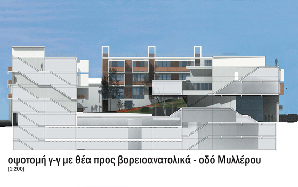
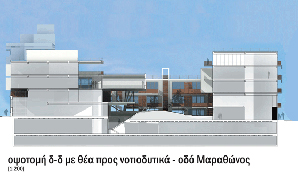
Germanikou Link: This street is the roughest in comparison, due to the narrowness [that leaves practically no sidewalk space] in conjunction with the poor construction quality and the overall height of the polykatoikias. These are however the attributes which constitute this street as an ultimate case of hyper-compressed urbanism. Towards this boundary the image of density is reinforced through the ascetic frontage of linear and narrow balconies similar to these of a common multi-story residential slab. The perimeter gap towards this street occurs at the point where the existing linear street-front [opposite] betrays its uncertainty, where illegal additions and multiple setbacks reveal their rough face of brute realism [party walls and awkward forms], but also where a more humane aspect of city life offers a hint of yesterday's Athens: just before the corner with Marathonos Street, through the small-sized cafeneion and the older left-over small residence. This location of the passag ensures maximum continuity of the Marathonos volume and its consistent scalar response to the neighborhood, allowing a more drastic shift in height and volume along Germanikou Street, where the imposing scale of the northern portion of the site progressively breaks down and disperses. From this passage, the slightly oblique side view of the "folie" [pavilion] volume frames the long perspective view, inevitably terminated at the adjacent blind party walls.
Blind Adjacencies: The existing party walls of the adjacent buildings - great concern for every design proposal - are here absorbed into the synthesis, acting as a backdrop, as a set design that frames and reveals the featured tectonic theme of the court, the so-called folie [or "sushi"] volume. The awkward situation of the "missing tooth" siting case on Leonidou Street is resolved through the reversal of the ordinary solution: a building volume is inserted to fill-in the gap; the isolated inner elevation of this volume would be normally presumed to line up with the blank party walls. This is not the case though: the whole building volume extends and flows as a powerfully dynamic feature over the central area of the court becoming the most recognizable and idiosyncratic element within the project.
Reversing Impediments: "Harsh" Athenian sites easily cancel all design intentions, imposing a struggle for the resolution of individual difficulties, aiming at [merely] decent and livable but often premature architectural schemes. Overwhelmed by tedious partial issues that impose individual attention and dissolve the overall project vision, designers often sacrifice greater visions or ambitions, ending up merely facilitating needs through utilitarian solutions. Still, in the proposed scheme all site parameters and intricacies are absorbed and digested in an architectural idea that ultimately generates an iconic image. The incorporation of the blind party wall into the overall courtyard scenery and the mixed-use programmatic entity on Leonidou Str. manifests this clearly.
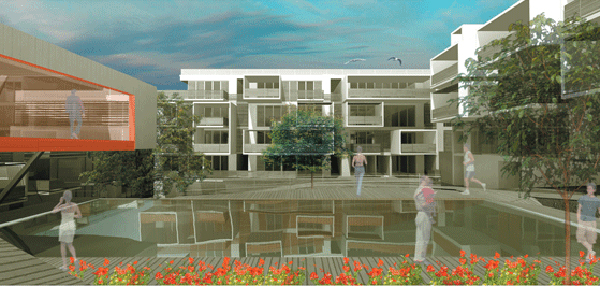
Hovering Pavilion: The "folie" volume is by definition the most intricate programmatic entity of the complex. The ground and first floor are devoted to retail responding to the flow of pedestrians [a bus line stops right in front of the building]. The upper floors, closer typologically to the organizational parti that encompasses the whole project, feature space fit for commercial and as well as residential use. Convenient public access is offered all the way to the large terrace over the top floor, offering views both towards the Acropolis and the Historic center, making the swimming pool and the atrium area a spectacle for visitors, creating ideal conditions for a gathering event area. Closer to the party wall, a programmatic shift occurs: a more isolated space, accessible primarily through the swimming pool deck is generated as an elevated pool-house, a relaxation area; the residents' event room. This space can potentially be unified with the commercial spaces in this volume generating a grander venue for communal events.
Folie Morphologies: The Leonidou volume, set in a relatively unresolved streetscape, is deliberately differentiated from the adjacent buildings of ambiguous character. Diverse parameters influence its geometry: the imposed dimensions of the vacant urban slot it occupies; the necessity to offer a public route connecting the atrium to the street; the significance of its central location within the project; the preservation of the old freestanding faηade wall [remnant of a listed residence] oddly placed on the front property boundary. The street elevation is finally set back from the preserved and restored wall, while the floors above hover as deep cantilevers exploiting the prescribed building code exemptions. Set against the party wall, a narrow public route leads through the Leonidou volume to the inner atrium and the swimming pool area. In the atrium, the protruding portion of the folie is a pure cantilevered box with strip windows and partially subtracted surfaces, supported by a number of randomly placed thin tubular columns. The volume casts shadow onto some portion of the pool deck, generating a more controlled environment optimal for the hotter months of the year. The piloti enables the visual and functional link of the court to the Leonidou wing.
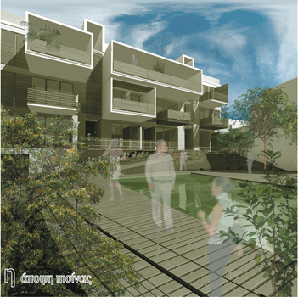
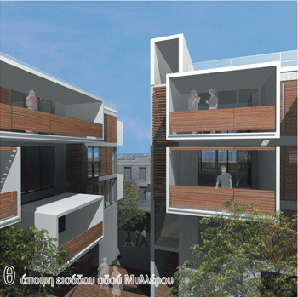
Street-front Retail: The ground-level stores follow the same organizational motif as the residential spaces: more spatial bays may be connected and unified. The retail zone may also grow upwards, occupying space on upper floors. The circulation system [the staircases and lifts] may serve literally any reformation. Access to underground storage space is provided systematically. The retail spaces are two-story on the street elevation with full-height glazing. An added lightweight mezzanine level can possibly utilize this extra volume. The stores are still accounted as single floor entities in reference to the building code. In Germanikou Street, in section, the double height of the retail zone is maintained only for the front portion of the space, on the street edge, while the back portion of the first floor is devoted to residential use, responding to the topographical shifts within the atrium and to the requirements of the building code.
Atrium Domesticity: The raised datum/urban space of the court with the pool is a new urban plateau semi-secured from city distractions, sloping along the natural contours, offset vertically as to allow for commercial ground floor uses to expand into and under the court with no visual interference of the purely residential court. The mound seals the back elevation of the ground floor retail spaces. Allowing the urban block to operate in a normative way within the city, courtyard access to commercial space was avoided. Internally accessed commercial uses contrast and reverse the main focus of domesticity in the court area, casting the undesirable qualities of a mixed-use introverted scheme. Responding to need, the retail spaces facing Myllerou Street may expand, sharing or dividing the additional commercial space hidden under the atrium mound. Behind the building footprints, the generated extra height of the slope enables generous commercial uses: a supermarket, a department store, a small theater, or event rooms and cinemas are here not out of question. This hidden retail zone is fully serviced [offers skylights] and extends all the way to the Leonidou building, offering possibilities for the creation of a large store with dual access from Myllerou and Leonidou Streets.
Swimming Pool: The piscine dimensions were decided in response to the overall size of the complex. The volumetry partially contrasts the directive of the play=mound for the atrium space. The pool was positioned towards the top of the mound flattening a relatively large portion of the outdoor topography. Though this aspect of the design is relatively unresolved at the competition entry stage, the formal move was to reveal the side elevation of the pool, and show portion of the deck area in cantilever allowing the peeled-off piscine box to contrast the overall mound topography.
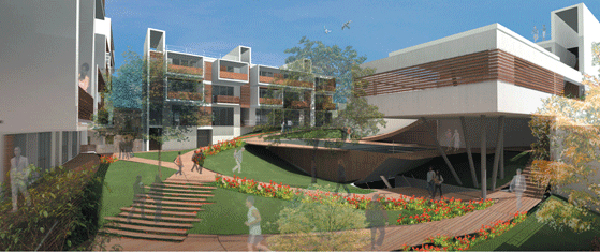
Stacking Carports: As suggested in the competition brief, the underground garage ramps are located in the descending portion of the topography, closer to the lower contour lines. This choice minimizes the length of the ramps. Two garage levels are offered, with a simple layout allowing for convenient utilization of all available spaces. Utilizing the depth of the housing footprints, in some cases double parking is offered, requiring a degree of coordination between vehicle owners. The first basement offers a great number of storage units in repetitive modules, easily resizable. These are available for the residential occupants and for the retailers, or, alternatively, can be rented out. The parking levels are accessed through the private elevators directly from the residential units, or through the limited number of stairs that connect to the street level and the interior courtyard. A new stairway access route is offered at the edge of the "folie" volume in Leonidou Str., connecting directly from the central area of the courtyard and from the back area of the "folie" to the underground levels, offering a more experiential route to the visitors of the complex. Escape routes are offered according the local fire regulations. All private stairs offer access to the underground spaces. These routes are utilized by the lower-level apartments and mainly by the ground-level retailers requiring constant access to storage areas. Roughly 100 parking places are offered surpassing the expectations of a commercial developer and the requirements of the competition brief.
Accessibility [ADA]: Inherently, the system optimizes the movement options of the elderly or the physically restricted. The even distribution of elevators leading directly to all levels overcomes the issues imposed by the programmatic fragmentation into small floor-plates and multiple levels. The open atrium is by default a smoothed-out surface with ramp access throughout.
Faηade Aspects: The differentiated possibilities of the inward-facing elevations versus the street frontage are reflected in the elevations. The long linear balcony, typical of the downtown polykatoikias, is adopted here as a response to concerns of marketability and also as an act of responsiveness to contextual givens. All non-structural surfaces are fully glazed, with solid shutters and options for non-transparent lightweight paneling. The sliding glass door and wood shutter system in combination with the continuous balconies creates great interior planning flexibility. The constant shift of the movable faηade elements [glazing panels and wood shutters] activates and animates the complex. A definite number of versions for the balcony design were created and the various types are distributed following a randomized pattern on the elevations, avoiding a strict institutionalized character. Wood paneling and wood shading grillage units fronting the staircases, glass and exposed white concrete are the primary materials of the project.
Related articles:
- HORROR VACUI: JOSTLE, HUDDLE AND HELLENIC MODERNITY ( 21 June, 2005 )
- ATTIC ECTOPIA ( 16 November, 2012 )
- FRONTAGE SHOWCASES AND THE POST-URBAN UNCANNY-A RECTROACTIVE MANIFESTO FOR HELLENIC PROFESSIONAL SPACES ( 01 January, 2010 )
- VI: Unrecycling Cyclades. Part 1 ( 04 October, 2010 )
- Gwangju Asian Cultural Center, Korea – International Competition Entry, October ( 7 December, 2007 )
- De-institutionalizing Education: Notes on Academic Initiatives(i) ( 7 July, 2007 )
- HARBORING CAR-BAN-ITIES [Port Nord Organizational Protocols] ( 8 October, 2007 )
- Stratifying Axialities> Celadina ReCelled (PART A) ( 14 March, 2008 )
- Stratifying Axialities> Celadina ReCelled (PART B) ( 11 April, 2008 )
- FRAGMENTARY IMPUNITIES > VALLADOLID TRAJECTORIES (PART A') ( 5 September, 2008 )
- FRAGMENTARY IMPUNITIES > VALLADOLID TRAJECTORIES (PART B') ( 5 November, 2008 )
- SUBTERRA * SUPRATERRA ( 22 May, 2009 )
- VI: Unrecycling Cyclades. Part 2 ( 14 October, 2010 )
- Translocality as a Post-Native Narrative ( 16 February, 2011 )
- L-I*-THEKE ( 02 April, 2013 )
- House - glyptotheque - gallery - workshop ( 19 July, 2013 )
- Piloting Pilotis ( 31 December, 2013 )
- Escalteca of the Choetheque Series ( 01 April, 2014 )
- Schottheke of the Choetheque Series ( 01 June, 2014 )
- Floatheca Rh of the Choetheque Series ( 01 August, 2014 )
- Floatheca Sp of the Choetheque Series ( 26 September, 2014 )
- O-theke of the Choetheque Series ( 11 March, 2015 )
- Floatheca Cy of the Choetheque Series ( 03 January, 2015 )
- Ophthalteca ( 24 June, 2015 )
- Y-theca of the Choetheque Series ( 08 October, 2015 )










